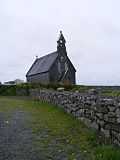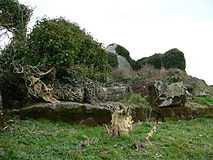Noughaval
| Noughaval Nuachabháil | |
|---|---|
| Parish | |
|
Ruins of the medieval church at Noughaval | |
 Noughaval | |
| Coordinates: 53°01′00″N 9°10′57″W / 53.016629°N 9.182557°WCoordinates: 53°01′00″N 9°10′57″W / 53.016629°N 9.182557°W | |
| Country | Ireland |
| Province | Munster |
| County | County Clare, County Limerick |
| Time zone | WET (UTC+0) |
| • Summer (DST) | IST (WEST) (UTC-1) |
Noughaval or Nohoval (Irish: Nuachabháil[1]) is a civil parish in County Clare, Ireland.
Location
The parish lies on the southern boundary of the barony of Burren. It is 2.25 miles (3.62 km) to the north of Kilfenora. It is 4 by 2 miles (6.4 by 3.2 km) and covers 4,661 acres (1,886 ha). The land is mostly rocky limestone pasture, with little land suitable for cultivation. It slopes up to an altitude of 635 feet (194 m) in the north of the parish. Lough Aleenaun lies in the east. In 1841 the population was 450 in 65 houses. The hamlet of Nohaval had 64 people in 10 houses. In 1845 the Nohoval and Carrune chapels were united.[2]
Antiquities
The name of the parish means "new acquisition". The old church was in fair condition in 1897, with a nave and a choir surrounded by a cemetery. A stone pillar near the church is said to be a market cross, and some lines drawn on were used as measures of length. There is a holy well nearby dedicated to Saint Colman MacDuach.[3]
The parish contains several caves built of limestone flags, either hiding places or storage rooms. There are many cahers, or stone forts, now ruined.[3] The parish has several cromlechs.[3] There is an exceptionally large cromlech at Ballygannor. The table stone is almost 40 by 10 feet (12.2 by 3.0 m) in dimensions, supported by upright flagstones and rising about 6 feet (1.8 m) above the ground.[4]
There are three ancient forts in the parish, said to have been built by the Danes. The ruins of the old church stand on the glebe in Nohaval. There are ruined castles at Banroe, Ballymurphy and Ballygannor.[4] These were the property of the O’Loghlen family in 1580.[3]
Townlands
Townlands are Ballyganner North, Ballyganner South, Ballymahony, Ballymurphy, Cragnarooan, Deerpark, Kiltaan, Kiltennan North, Kiltennan South, Knockavoarheen, Lismoher, Noughaval, Rusheen and Sheshymore.[5]
-

Limestone pavement near Noughaval
-

Saint Mochua's Church - Noughaval Townland
-

Ruins at Noughaval
References
Citations
Sources
- Frost, James (1897). "Burren, or Corcomroe East, Noughaval Parish". The History and Topography of the County of Clare. Retrieved 2014-04-07.
- Lewis, Samuel (1837). "Noughaval". County Clare: A History and Topography. Retrieved 2014-04-07.
- "Map of Noughaval Parish showing Townlands". Clare County Library. Retrieved 2014-04-07.
- "Nuachabháil". Placenames Database of Ireland. Retrieved 2014-04-07.
- "Nohoval, or Noughaval". Parliamentary Gazeteer of Ireland. 1845. Retrieved 2014-04-07.
| ||||||||||||||||||||||||||||||||||||||||||||||||||||||
